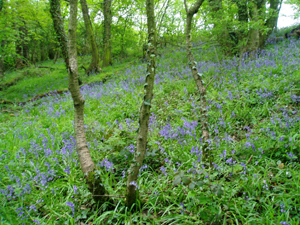
Boilton Wood:
That an accessible woodland nature reserve should lie so close to an urban centre is always a bonus, but Boilton Wood is exceptional. It has a great deal to offer both the seasoned naturalist and the beginner. The western end of the Wood contains a distinctive area of even-aged, multi-stemmed sycamore, which has regenerated following felling during the 1939-45 war. Sycamore and wych elm dominate the remaining woodland. Although it has suffered from Dutch Elm Disease, the elm is regenerating well. Ash, oak, gean (wild cherry), hazel and holly are also present, and ivy can be seen winding up the trunks of trees. Spring is the best time to visit. Then there's an attractive display of bluebells and lesser celandine, with ferns and wood avens emerging during the summer. Wild flowers that are less obvious include ground-ivy, dog-violet and cuckoo-pint. Towards the bottom of the slope, in the marshy areas crossed by boardwalks, yellow iris, marsh marigold and meadowsweet are quite common.
Boilton Wood is also a haven for birds including treecreepers, spotted flycatchers, great and lesser spotted woodpecker, and various finches and tits. You may also see grey squirrels scampering up the trees, but the red squirrel is extinct here.
Red Scar Wood, Tunbrook Wood and
No Comments Yet - Why not be the first to leave a comment
Every effort is made to make sure that all the information is correct but we strongly recommend that you call Boilton, Nab, Redscar and Tunbrook Woods before you set off on your day out to confirm opening times and admission prices.
Please also note that the position on Google maps for Boilton, Nab, Redscar and Tunbrook Woods is a rough estimate using their postcode in the database and might be slightly out.
It may also be worth clicking the web link for Boilton, Nab, Redscar and Tunbrook Woods to see if there are any special events coming up or currently on.